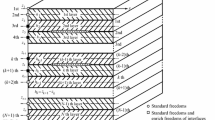Abstract
This work deals with the Cohen–Monk Perfectly Matched Layer (PML) model. We first carry out the stability analysis of its equivalent form. Then we propose and analyse a finite element scheme for solving this equivalent PML model. Discrete stability and optimal error estimate are established. Numerical results are presented to justify the analysis and effectiveness of this PML model. This paper presents the first mathematical analysis for this PML model and the corresponding numerical analysis for the proposed finite element scheme.


Similar content being viewed by others
References
Appelö, D., Hagstrom, T., Kreiss, G.: Perfectly matched layers for hyperbolic systems: general formulation, well-posedness, and stability. SIAM J. Appl. Math. 67(1), 1–23 (2006)
Bao, G., Li, P., Wu, H.: An adaptive edge element method with perfectly matched absorbing layers for wave scattering by biperiodic structures. Math. Comp. 79, 1–34 (2010)
Bécache, E., Joly, P., Kachanovska, M., Vinoles, V.: Perfectly matched layers in negative index metamaterials and plasmas. ESAIM Proc. Surv. 50, 113–132 (2015)
Bérenger, J.P.: A perfectly matched layer for the absorbing EM waves. J. Comput. Phys. 114, 185–200 (1994)
Bokil, V.A., Buksas, M.W.: Comparison of finite difference and mixed finite element methods for perfectly matched layer models. Commun. Comput. Phys. 2, 806–826 (2007)
Bonnet-Ben Dhia, A.-S., Carvalho, C., Chesnel, L., Ciarlet Jr., P.: On the use of perfectly matched layers at corners for scattering problems with sign-changing coefficients. J. Comput. Phys. 322, 224–247 (2016)
Cohen, G.C., Monk, P.: Mur-Nédélec finite element schemes for Maxwell’s equations. Comput. Methods Appl. Mech. Eng. 169, 197–217 (1999)
Hong, J.L., Ji, L.H., Kong, L.H.: Energy-dissipation splitting finite-difference time-domain method for Maxwell equations with perfectly matched layers. J. Comput. Phys. 269, 201–214 (2014)
Huang, Y., Li, J., Yang, W.: Mathematical analysis of a PML model obtained with stretched coordinates and its application to backward wave propagation in metamaterials. Numer. Methods Part. Differ. Eq. 30, 1558–1574 (2014)
Huang, Y., Li, J., Yang, W., Sun, S.: Superconvergence of mixed finite element approximations to 3-D Maxwell’s equations in metamaterials. J. Comput. Phys. 230, 8275–8289 (2011)
Kong, L.H., Hong, Y.Q., Tian, N.N., Zhang, P.: Stable and efficient numerical schemes Maxwell equations in lossy medium. J. Comput. Phys. 397, 108703 (2019)
Li, J.: Finite element study of the Lorentz model in metamaterials. Comput. Methods Appl. Mech. Eng. 200, 626–637 (2011)
Li, J., Hesthaven, J.S.: Analysis and application of the nodal discontinuous Galerkin method for wave propagation in metamaterials. J. Comput. Phys. 258, 915–930 (2014)
Li, J., Huang, Y.: Time-Domain Finite Element Methods for Maxwell’s Equations in Metamaterials, Springer Series in Computational Mathematics, vol. 43. Springer, Berlin (2013)
Lin, Y., Zhang, K., Zou, J.: Studies on some perfectly matched layers for one-dimensional time-dependent systems. Adv. Comput. Math. 30, 1–35 (2009)
Monk, P.: Finite Element Methods for Maxwell’s Equations. Oxford University Press, Oxford (2003)
Taflove, A., Haguess, S.C.: Computational Electrodynamics: The Finite-Difference Time-Domain Method, 3rd edn. Artech House, Norwood (2005)
Author information
Authors and Affiliations
Corresponding author
Additional information
Publisher's Note
Springer Nature remains neutral with regard to jurisdictional claims in published maps and institutional affiliations.
Partially supported by NSF of China Project No. 11971410, and NSF Grant DMS-20-11943, NNSFC (No. 11961036).
Rights and permissions
About this article
Cite this article
Chen, M., Huang, Y. & Li, J. Development and analysis of a new finite element method for the Cohen–Monk PML model. Numer. Math. 147, 127–155 (2021). https://doi.org/10.1007/s00211-020-01166-4
Received:
Revised:
Accepted:
Published:
Issue Date:
DOI: https://doi.org/10.1007/s00211-020-01166-4




